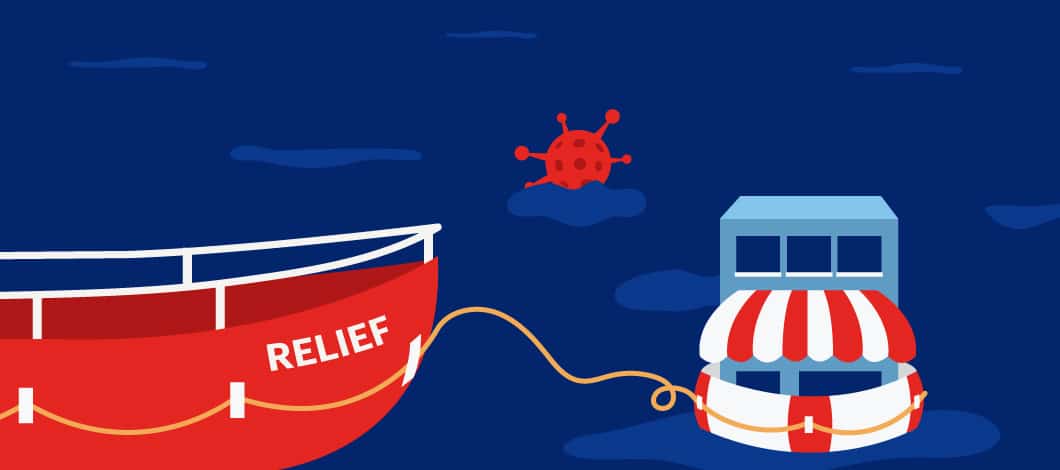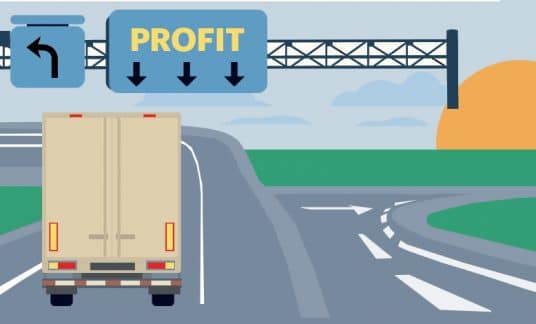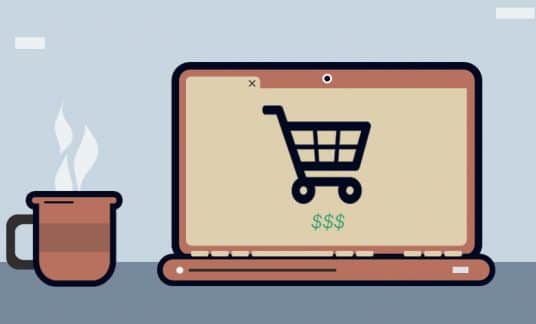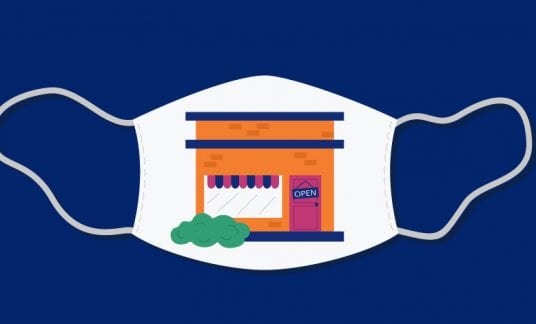Are your COVID-19 business losses mounting up? Here are 15 strategies to help you recoup:
- Check your eligibility for federal relief
- Apply for financing
- Reduce on-site expenses with remote workers
- Use outsourcing to cut labor expenses
- Increase efficiency with automation
- Refocus your marketing angle
- Leverage your best marketing material
- Improve your sales pitch
- Increase your average value per transaction
- Increase your customer lifetime value
- Improve your customer retention rate
- Extend your customers a special offer
- Invite inactive customers back
- Form alliances with promotional partners
- Make sure you’re claiming all your tax deductions and credits
Learn how these methods can help you recover your losses and persevere through the pandemic.
1. Check Your Eligibility for Federal Relief
The deadlines for some forms of COVID-19 federal relief have passed. Nov. 21, 2020, was the deadline to apply for an Economic Impact Payment (EIP) under the Coronavirus Aid, Relief and Economic Security (CARES) Act.
However, even if you missed the deadline, the Internal Revenue Service (IRS) advises that you still may be eligible to receive your initial impact payment under certain circumstances:
- If you didn’t register for one and receive one
- If you didn’t receive the full amount of $1,200 for individuals or $2,400 for couples filing jointly, plus $500 per qualifying child
Additionally, under U.S. Treasury guidelines, state and local governments have until December 30 to allocate Coronavirus Relief Fund payments or return them to the federal government, so some areas continue to distribute money to businesses. For instance, the city of Austin is rushing to disburse CARES funding to businesses before the deadline.
The Latest Economic Relief Package
On Dec. 21, 2020, federal lawmakers agreed upon the text of a $900 billion Consolidated Appropriations Act for 2021 to authorize new COVID-19 relief measures. (The president has yet to sign the bill.)
Items relevant to business owners include:
- $600 stimulus checks for adults and children earning up to $75,000, with smaller checks for those earning between $75,000 and $99,000
- $300 a week unemployment benefits for 11 weeks for unemployed workers, including benefits for self-employed business owners and gig workers
- $319 billion in financing for small businesses, including $284 billion for Paycheck Protection Program (PPP) loans and $20 billion in Economic Injury Disaster Loan (EIDL) distributions
- $10 billion to help child care providers remain open
- A tax credit for employers offering paid sick leave
- An extension of the Employee Retention Credit tax benefit
Depending on your situation, you may be eligible for these or other provisions of the act.
2. Apply for Financing
Even if you aren’t eligible for federal coronavirus relief packages, you may be eligible for other forms of small business financing which can help you recover from the pandemic.
For example, if you have good credit and meet other qualifying criteria, you may be able to obtain a business credit card or term loan. If you have receivables coming in forms such as unpaid invoices or projected sales, you may be able to qualify for forms of financing which use these assets as collateral, such as invoice factoring or merchant cash advances.
Small businesses that have exhausted other options may be eligible for SBA loans. Talk to your financial adviser or get in touch with our team at Fast Capital 360 to find out what types of financing you may be eligible for.
3. Reduce On-Site Expenses With Remote Workers
A brick-and-mortar work center incurs expenses such as rent, utilities and maintenance in addition to the cost of running on-premise computer equipment. You may be able to trim these costs by shifting some of your workforce off-site as remote workers so that you can downsize or eliminate your physical facility.
This may be more convenient for some of your workers as well as more cost-efficient for you, making it a possible point of negotiation. For instance, working parents may find it easier to take care of children if they can work from home. About a third of workers would be willing to take a pay cut for the option of working from home at least some of the time, according to a survey by consulting firm Global Workplace Analytics.

4. Use Outsourcing to Cut Labor Expenses
Another way to cut costs by using off-site workers is to outsource select business functions and tasks. Outsourced labor avoids the expense of paying for employee benefits, and for some tasks, costs can be reduced by scaling billable hours to your actual usage level. Outsourcing also can save you money by increasing efficiency.
You can outsource tasks that lie outside your team’s core competence or which could be performed more efficiently by specialists. Examples of commonly outsourced tasks include:
- Accounting
- Administrative support
- Technical support
- Marketing lead generation
- Content creation
- Sales
- Customer service
Review your current organizational structure, and seek to identify places where outsourcing might cut your costs.
5. Increase Efficiency With Automation
Automation provides another strategy for cutting labor costs and increasing efficiency. You can use automated apps to decrease the time and expense of performing repetitive tasks or to increase the scale of your activity at a cost-efficient rate.
Here are some examples of ways automation can help you cut costs or increase your revenue:
- Reducing data entry labor by automatically syncing data between your sales transaction software and your accounting software
- Saving you time on fielding routine customer-service inquiries
- Helping you track which marketing campaigns are performing well and which are underperforming so that you know where to invest your resources
- Allowing you to identify your most qualified prospects so that you can focus your sales team on your best opportunities
Review your workflow, and look for places where automation might help you streamline repetitive tasks or scale up your results.
6. Refocus Your Marketing Angle
Increasing your revenue is another way to recover COVID-19 business losses. One of the most efficient ways to multiply your revenue is refocusing your marketing angle to better align with your target market. You can use a number of strategies to recalibrate your marketing emphasis:
- Speak to a different niche audience
- Address a different problem more relevant to your audience
- Emphasize a different benefit more desired by your audience
- Offer more value than your competition
- Promise higher quality than competitors
- Deliver better service
- Change your price by lowering it to reach more consumers or raising it to appeal to luxury buyers
To put your new marketing angle to practical use, encapsulate it in a short statement, known as a unique selling proposition (USP). Your USP briefly tells audiences what you offer, why they should want it and why they should get it from you instead of someone else.
An effective USP should be short enough that you can use it in marketing formats that only allow you a short amount of space, such as blog headlines, Twitter messages and email subject lines.
7. Leverage Your Best Marketing Material
Creating new marketing material can be costly, but you can reduce your costs and increase your results by leveraging material you’ve already created.
If you’ aren’t already tracking your marketing campaign performance, begin using analytics tools to track key performance indicators (KPIs), such as:
- Which of your blog posts are drawing the most organic traffic to your site
- Which of your social media posts are driving the most visits to your site
- Which of your content is generating the most clicks to your sales pages
- Which of your email campaigns are generating the most clicks to your sales pages
Tracking these numbers can help you identify which pieces of marketing material are generating the best results for you. You can then scale up your use of high-performing material.
For instance, if one of your blog posts is doing a superior job of attracting organic traffic, consider using paid search engine or social media ads to increase the reach of this post.
8. Improve Your Sales Pitch
Improving the language you use on your sales pages and in your sales presentations can increase your conversion rate and revenue results. You can tweak your sales pitch at a number of key points:
- Use a different headline on your sales page
- Solve a different problem
- Emphasize a different benefit
- Use a demonstration or free trial
- Change the price
- Add a bonus
- Include a guarantee
- Answer common sales objections
For best results, test different samples of your sales language and track their performance to see which one works best. Even a small change may deliver big results.
9. Increase Your Average Value Per Transaction
Your revenue is a product of the number of sales transactions you make times the average value per transaction.
You can use a number of methods to increase the average amount of revenue you generate per sale:
- Increase your price
- Bundle products or services together into a package
- Offer complementary products or services at the point of sale (cross-sell)
- Suggest a higher-priced product or service instead of the original item (upsell)
You will find it easier to use some of these techniques if you have multiple product and service lines to offer at the point of sale.
Consider ways you might expand your current lines of product and services to create more sales opportunities. For example, you might survey your customers to find out what other products and services they want.
10. Increase Your Customer Lifetime Value
Another key metric directly affecting your revenue is the average amount a customer spends with you over the lifetime of their relationship with your brand. You can increase this amount by using 2 main strategies:
- Increasing average value per transaction, using the methods described above
- Increasing the number of times a customer purchases from you
To increase the number of times a customer buys from you, one method you can use is adapting the cross-sell and upsell tactics used for increasing value per transaction. Develop offers of complementary and higher-priced products and services which you can extend customers periodically after their initial purchase. Map out a timetable scheduling when you will extend these offers to customers, known as a customer journey map.
For instance, you might develop an offer to extend to customers who have been using your product for 6 months, designed to address the needs you anticipate they may have at that time.
Another strategy for increasing purchase frequency is requiring a periodic renewal of a subscription or license. This can work well for digital products and services such as software subscriptions.

11. Improve Your Customer Retention Rate
How much your customers spend with you depends on how long they remain your customers. You can increase the amount your customers spend and decrease your marketing costs by taking steps to increase your customer retention rate.
You can improve customer retention by:
- Offering better service, such as customized selection or free shipping
- Taking steps to improve customer support, such as responding more quickly to support issues
- Keeping in touch with customers after their initial purchase by sharing content through your social media profiles, emails and text messages
- Sending customers personal messages for special events such as birthdays, anniversaries and holidays
- Periodically offering customers special discounts
The more work you put into keeping customers, the more you’ll earn from them and the less you’ll have to spend on marketing to find new customers.
12. Extend Your Customers a Special Offer
A great way to promote customer retention while boosting your sales is to extend your customers a special offer. Your offer can include a discount price, a bonus or other incentives.
You can use a number of reasons to extend a special offer:
- Customer appreciation
- Coronavirus discount
- Holidays
- Tie-ins to other cultural events, such as sports events or movie releases
- Product launches
- Opening new locations
- Launching new websites
Look for reasons to extend special offers to your customers and create opportunities for sales.
13. Invite Inactive Customers Back
You also can extend offers to customers who haven’t purchased from you in a while. Because these customers are already in your database, you don’t need to invest additional marketing spend to acquire them. You just need to come up with an offer compelling enough to recapture their interest.
Customers who haven’t purchased from you recently fall into a few different categories, each requiring different tactics:
- Customers who haven’t purchased recently simply because they haven’t heard from you in a while may respond to the same types of offers which would appeal to other customers
- Customers who left because they were dissatisfied with your product, service or support may respond to an offer which seeks to make amends, such as a discount
- Customers who left because they switched to a different brand may respond to an offer which appeals to them more than your competitor’s offer, such as a lower price or an updated product or service
To reach all these different groups, you can extend different offers to corresponding segments of your customer database. One way to determine which group a dormant customer falls into is to send out an email survey to customers who haven’t purchased for a certain length of time asking why you haven’t heard from them.
14. Form Alliances With Promotional Partners
One of the fastest ways to increase your volume of sales opportunities is to form alliances with promotional partners. If you can find partners who are willing to promote you to their customer base, you can multiply your leads without significant marketing expenditures.
Look for partners who sell to your target audience but don’t sell a competing product or service. Compile a list of potential partners and prioritize them. For each partner, develop a customized approach offering them a reason for partnering with you.
Incentives you can offer for partnering with you include:
- Offering a commission on sales
- Providing your partner with free products or services in exchange for promotional consideration
- Cross-promoting your partner to your own customers
- Enhancing the value your partner offers to their own customers
By approaching qualified partners with strong incentives for promoting you, you can quickly add new leads to your marketing funnel at minimal to no cost.
15. Make Sure You’re Claiming All Your Tax Deductions and Credits
Another place you can recover losses from COVID-19 is your tax-filing strategy. Make sure you’re tracking your expenses and claiming all eligible deductions. An app which allows you to scan in expense receipts such as Shoeboxed can help you automate this process.
You also may be eligible for pandemic-related tax credits. For example, the CARES Act provides for an Employee Retention Credit for eligible wages paid between March 12, 2020, and Jan. 1, 2021. The website of the IRS provides details on this and other opportunities for coronavirus tax relief for businesses.
Persevere Through the Pandemic With Effective Loss Management
You may not be able to avoid all losses from COVID-19, but by taking proactive measures to recoup, you may be able to survive the pandemic and even thrive. Use the strategies suggested here to obtain financing, cut your costs and increase your revenue.
If you need a temporary cash injection to sustain your business through these tough times, consider applying for a short-term business loan or other small business financing option.










